Executive Summary
SE/2007/183 Scottish Government Criminal Justice Directorate
Laid before the Scottish Parliament by the Scottish Ministers
Photographs courtesy of Dougie Barnett Photography
ISBN 978 0 7559 5474 2
This document is also available in pdf format (1mb)
Contents
Letter to the Scottish Ministers
Chapter 3 Summary of Inspections Undertaken 2008-2009
Chapter 4 Review of the Prison Inspectorate's Year 2008-2009
Previous Reports
1981 - Cmnd 8619
1982 - Cmnd 9035
1983 - Cmnd 9401
1984 - Cmnd 9636
1985 - Cmnd 9909
1986 - Cm 260
1987 - Cm 541
1988 - Cm 725
1989 - Cm 1380
1990 - Cm 1658
1991 - Cm 2072
1992 - Cm 2348
1993 - Cm 2648
1994 - Cm 2938
1995 - Cm 3314
1996 - Cm 3726
1997 - Cm 4032
1998 - Cm 4428 SE/1999/21
1999 - Cm 4824 SE/2000/71
2000 - SE/2001/227
2000 - SE/2000/71
2001 - SE/2001/227
2002 - SE/2002/191
2003 - SE/2003/287
2004 - SE/2004/207
2005 - SE/2005/175
2006 - SE/2006/198
Letter to the Scottish Ministers
To the Scottish Ministers
I have the honour to submit my fifth Annual Report to the Scottish Parliament.

ANDREW R C McLELLAN
HM Chief Inspector of Prisons for Scotland
30 August 2007
1. Overview
 Better Prisons in a Better Scotland
Better Prisons in a Better Scotland
The inspection of prisons should make prisons better; in turn that should make Scotland better. I have often said that we will only have better prisons when we have a better Scotland, since so many of the problems in our prisons are problems which prisoners bring inside with them. It is also true that we will have a better Scotland when we have better prisons. Better prisons can make Scotland safer by reducing re-offending; and better prisons can make Scotland more civilised by treating those in our power with increasing decency and respect.
In August 2006 an important step was taken in the reinforcement of the role of inspection in the development of better prisons. This was the publication of "Standards Used in the Inspection of Prisons in Scotland". The publication of standards is intended to be a reassurance to Scottish Ministers and to the public that the inspection of prisons is consistent, fair and transparent. It goes beyond asking "how well does the Scottish Prison Service do what it says it will do?" (however important that is). Independent inspection is concerned not only with what is possible but also with what is right. It is therefore essential that standards for inspection should not be merely subjective: the standards used in Scotland are firmly based in international treaties and conventions.
The idea which guides these standards is Article 10 of the UN International Covenant on Civil and Political Rights: All persons deprived of their liberty shall be treated with humanity and with respect for the inherent dignity of the human person.
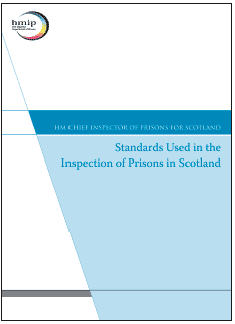 The standards are concerned with:
The standards are concerned with:
- Safety: security, good order, and the protection of prisoners from harm.
- Decency, humanity and respect for legal rights: all aspects of the treatment of prisoners and the framework of rights within which prisons should operate.
- Opportunities for self-improvement and access to services and activities: the activities provided by a prison, its ethos, measures taken to solve the problems that led a prisoner into crime, preparation for release and social integration.
Such standards might appear remote, based in international treaties which are not part of the ordinary life of Scottish prisons. So it is important that this document is understood as not merely theoretical, but as founded in the actual experience of inspecting prisons in Scotland. Since 1981 it has been the responsibility of HM Chief Inspector of Prisons in Scotland to report on "the treatment of prisoners and conditions in prisons". These standards reflect the actual experience of inspecting actual prisons for more than 25 years.Nine outcomes are identified in these standards:
- Appropriate steps are taken to ensure that prisoners are protected from harm by themselves and others.
- Prisoners are treated with respect for their dignity while being escorted to and from prison, in prison and while under escort in any location.
- Prisoners are held in conditions that provide the basic necessities of life and health, including adequate air, light, water, exercise in the fresh air, food, bedding and clothing.
- Prisoners are treated with respect by prison staff.
- Good contact with family and friends is maintained.
- Prisoners' entitlements are accorded to them in all circumstances without their facing difficulty.
- Prisoners take part in activities that educate, develop skills and personal qualities and prepare them for life outside prison.
- Healthcare is provided to the same standard as in the community outside prison, available in response to need, with a full range of preventive services, promoting continuity with health services outside prison.
- Appropriate steps are taken to ensure that prisoners are reintegrated safely into the community and where possible into a situation less likely to lead to further crime.
So, in the light of these outcomes, how well are Scotland's prisons doing?
Appropriate steps are taken to ensure that prisoners are protected from harm by themselves and others.
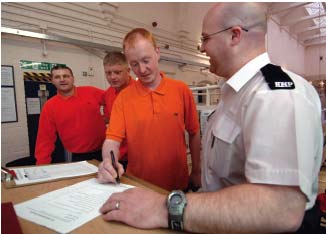 One of the brightest spots in the inspection year was the First Night Centre at Barlinnie. Imprisonment can be terrifying; and particularly terrifying when the number admitted is very high. On most Monday nights in 2006-2007 there were about 120 people admitted to Barlinnie alone. The initiative of the First Night Centre, and the commitment of the staff to its operation, makes it considerably less likely that a new prisoner will be lost in the crowd. All prisoners are admitted to a dedicated part of the prison, where trained staff take them through a programme of information and answer questions. The report on Barlinnie said it is difficult to overestimate the difference this initiative has made….The First Night Centre is designed to make introduction to prison life as safe, reassuring and straightforward as possible...
One of the brightest spots in the inspection year was the First Night Centre at Barlinnie. Imprisonment can be terrifying; and particularly terrifying when the number admitted is very high. On most Monday nights in 2006-2007 there were about 120 people admitted to Barlinnie alone. The initiative of the First Night Centre, and the commitment of the staff to its operation, makes it considerably less likely that a new prisoner will be lost in the crowd. All prisoners are admitted to a dedicated part of the prison, where trained staff take them through a programme of information and answer questions. The report on Barlinnie said it is difficult to overestimate the difference this initiative has made….The First Night Centre is designed to make introduction to prison life as safe, reassuring and straightforward as possible...
A much respected prison governor once told me that the worst effect of prison overcrowding was the difficulties it put in the way of providing any serious assessment of the likelihood that a new prisoner might be suicidal. Although the Barlinnie admission numbers are very high, the First Night Centre does provide the sort of structure which at least gives prison staff a chance to identify those prisoners most at risk of attempting to take their own lives.
The number of suicides in Scottish prisons has reduced: last year there were nine, ten years ago there were 17. Each one is a personal tragedy, from which families may never recover; and each suicide is also a painful and demanding experience for prison staff and prisoners. An important part of the inspection process is to examine in each prison the quality of the training for the ACT2CARE strategy, the Scottish Prison Service anti-suicide policy. Across all prisons there is a very high level of competence.
The Annual Prisoner Survey carried out by the SPS shows that most prisoners feel safe: in answer to the question Have you feared for your safety in this prison in the last month?, 83% of prisoners answered "No". This is an extraordinary figure. But it reflects what inspections find. Scottish prisons are by no means hotbeds of violence. It was very different in the 1970s, when Jimmy Boyle wrote A Sense of Freedom. The picture of ceaseless confrontation between prison staff and prisoners and among prisoners is unrecognisable in a Scottish prison today. The statistics show that violence from a prisoner towards a prisoner has steadily reduced. Violence from a prison officer toward a prisoner is almost unheard of. I make a point of finding ways to enable prisoners to feel able to speak of physical ill-treatment from prison staff: they never consider it even to be a possibility. When I have heard such an allegation (perhaps four times in five years) it has always been in the context of a proper restraint on a prisoner reaching the boundary of acceptable force. The days of prison officers wilfully and systematically beating up prisoners, which Jimmy Boyle wrote about, are gone.
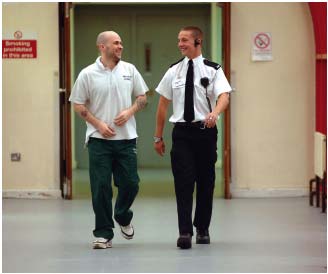 For example, the Report on Shotts says: Over the last few years management and staff have worked hard, and have been bold in their strategy, to reduce the level of violence in the prison. During the inspection the view was often expressed by prisoners and staff alike, that the prison was a very different place from the prison of years ago. The statistics on violence support this.
For example, the Report on Shotts says: Over the last few years management and staff have worked hard, and have been bold in their strategy, to reduce the level of violence in the prison. During the inspection the view was often expressed by prisoners and staff alike, that the prison was a very different place from the prison of years ago. The statistics on violence support this.
The prisoners who have most cause to feel unsafe from other prisoners are those convicted of sex offences. It is almost universal among "mainstream" prisoners to loathe sex offenders: such loathing is expressed very openly - it masquerades as a sense of morality - and is often accompanied with dire threats. Whenever sex offenders and other prisoners are held in the same prison they must be kept apart for the safety of the sex offenders. The report on Peterhead (the only prison which holds only sex-offenders) says it is a much safer environment for them than other prisons. The statistics confirm that there is little violence in Peterhead. The future of Peterhead has been in question since before I was appointed Chief Inspector and it remains in question. Whatever answers are found they must take full account of the safety of prisoners.
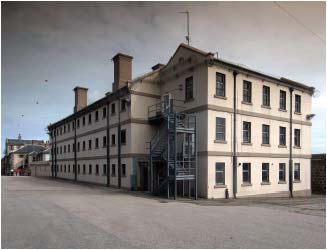 One significant factor in helping prisoners to feel safe has been the introduction of CCTV cameras. All the new halls built in the last few years have cameras installed. Wherever they are to be found prisoners say that they feel more safe because the cameras are there: I have never heard a prisoner complain about the presence of cameras.
One significant factor in helping prisoners to feel safe has been the introduction of CCTV cameras. All the new halls built in the last few years have cameras installed. Wherever they are to be found prisoners say that they feel more safe because the cameras are there: I have never heard a prisoner complain about the presence of cameras.
Prisoners are treated with respect for their dignity while being escorted to and from prison, in prison and while under escort in any location.
No issue raised in any report aroused more public concern than the revelation in August 2006 that two prisoners from Cornton Vale had been handcuffed in the labour room almost until the moment of birth and were put back in cuffs immediately after their babies were born. One national newspaper called the practice indefensible, incomprehensible and verging on the barbaric. When the report was published the escort contractor immediately announced that they had relaxed their security procedures for female prisoners. A spokesman for the contractor said then I think the feeling was the female prisoners should be treated differently to men because they are more vulnerable. That is a view we would subscribe to. Any change in procedure was temporary and this indefensible practice still continues, as a return inspection to Cornton Vale in 2007 confirmed. It is a scandal.
On the other hand inspections and the Scottish Prisoner Survey regularly point to good relationships between escort staff and prisoners. To the question How would you describe relationships with escort staff 83% of prisoners describe them as OK or better. On any inspection this question will be put to groups of prisoners; and inspectors will spend time observing escorts taking place (sometimes including travelling in a van). There has not been any evidence from these sources of relationships with prisoners which are not good.
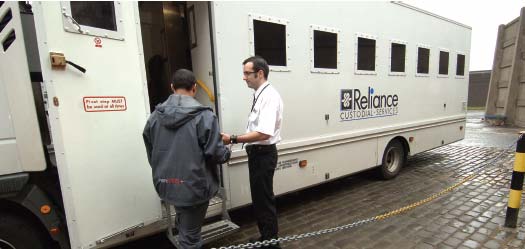
The conditions and treatment of prisoners under escort has been itself the content of a major piece on inspection work carried out in 2006-2007. This inspection reported that the overwhelming majority of escorts are managed without incident; delays in the escorting process are endemic; and the conditions in which prisoners are held in court cells are very variable, with some being extremely poor.
Prisoners are held in conditions that provide the basic necessities of life and health, including adequate air, light, water, exercise in the fresh air, food, bedding and clothing.
Scottish prisons have been transformed in the last four years. The improvement in living conditions is remarkable. The improvement is the result of the new building programme which has already produced huge residential halls at Polmont (2), Edinburgh (2), Glenochil (2); and other excellent new residential accommodation at the Open Estate and Cornton Vale. The improvement does not stop there: Barlinnie has been completely refurbished and new accommodation is about to be opened at Perth. There has never been a prison building programme like it in Scotland. The SPS deserve recognition for it, and in particular the Chief Executive who retired in 2007, Tony Cameron, deserves recognition for it.
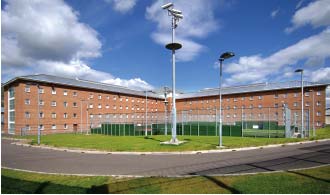 |
 |
The new accommodation is very much to be welcomed. After the first hall was opened at Polmont I reported that the improvement in motivation of staff and prisoners and in relationships between staff and prisoners which could be attributed to the new building was obvious. As the other new halls have opened, while questions emerge about their large size, there has been no reason to question that first assessment.
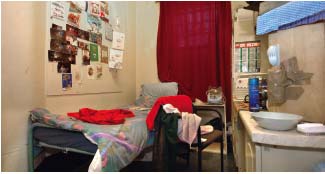 It has been a pleasure to report regularly in the last two or three years that "slopping out has ended" in prison after prison. There is still a form of slopping out at Peterhead, and it is very disappointing to note that there are no plans to bring it to an end. When slopping out ends in a prison the prison automatically, immediately and perceptibly becomes a more decent place: if Peterhead is to remain open it desperately needs to become a more decent place. The report on Barlinnie which welcomed the end of slopping out said It was repeatedly said by prisoners and staff that Barlinnie feels safer, looks cleaner, serves better food, has better relationships and a more calm atmosphere.
It has been a pleasure to report regularly in the last two or three years that "slopping out has ended" in prison after prison. There is still a form of slopping out at Peterhead, and it is very disappointing to note that there are no plans to bring it to an end. When slopping out ends in a prison the prison automatically, immediately and perceptibly becomes a more decent place: if Peterhead is to remain open it desperately needs to become a more decent place. The report on Barlinnie which welcomed the end of slopping out said It was repeatedly said by prisoners and staff that Barlinnie feels safer, looks cleaner, serves better food, has better relationships and a more calm atmosphere.
This prison building programme, however, should not be confused with "building more prisons". Nearly all of the new accommodation (the exceptions are Castle Huntly and Cornton Vale) is to replace dilapidated existing accommodation; and will do almost nothing to solve the problems of overcrowding. Indeed, the irony is that the advantages of the new halls are always threatened by overcrowding: far too many prisoners are crammed in to the new halls: cells are shared where there should be no cell-sharing, the staff-prisoner ratio is low, the noise level is much higher, and it is often found necessary to reduce the access of prisoners to recreation - all because of overcrowding. It is very sad that the advantages gained by the new building programme are being frittered away by the relentless rise in prison numbers. In last year's Annual Report I wrote of "the nine evils of overcrowding". None of them has gone away and our prisons are more overcrowded than they were last year.
 At the same time as new accommodation is being built, new facilities buildings, health centres, learning centres, workshops, kitchens, laundries are also appearing. In Perth the report found the new building provided "a very good environment for prisoners' work and training"; at the Open Estate inspectors found an "excellent facility" offering "very appropriate education and work opportunities in very appropriate settings".
At the same time as new accommodation is being built, new facilities buildings, health centres, learning centres, workshops, kitchens, laundries are also appearing. In Perth the report found the new building provided "a very good environment for prisoners' work and training"; at the Open Estate inspectors found an "excellent facility" offering "very appropriate education and work opportunities in very appropriate settings".
In successive Annual Reports I have identified four issues about the food of prisoners.
- Prisoners eat unhealthy food before they come into prison and like unhealthy food.
- The way food is transported from kitchen to hall can cause significant deterioration.
- The budget for food has not changed since 1996.
- Most prisoners are not provided with even half of the Scottish Executive minimum recommendations for fruit and vegetables.
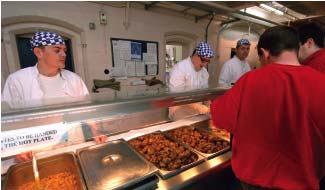 In two prisons this year, Perth and Barlinnie, it was possible to report some improvement in food. This can be attributed to a change in the method of serving, which has overcome the damage done to meals by being kept for a long time in sealed trays in heated trolleys. But the general picture of catering in 2006-2007 shows little change from previous years. The SPS has undertaken a significant review of food in prison: there is room for improvement.
In two prisons this year, Perth and Barlinnie, it was possible to report some improvement in food. This can be attributed to a change in the method of serving, which has overcome the damage done to meals by being kept for a long time in sealed trays in heated trolleys. But the general picture of catering in 2006-2007 shows little change from previous years. The SPS has undertaken a significant review of food in prison: there is room for improvement.
Prisoners are treated with respect by prison staff
Cartoonists enjoyed themselves in the newspapers with pictures of staff treating prisoners with exaggerated deference when this standard was published: but there are two serious points behind it. One is the point about what works: a prison will function better if prisoners are treated properly. The other is about our society and how we treat those who are in our power. Prison staff represent us all in the responsibility for the custody of prisoners.
One of the most noticeable changes in prisons over the last twenty years is that first names are now the norm. When I ask prison staff about this, almost without exception they think it is a move in the right direction: it helps to create a less confrontational and more human relationship. The most marked change is perhaps in Polmont and in the respect shown to prisoners there.
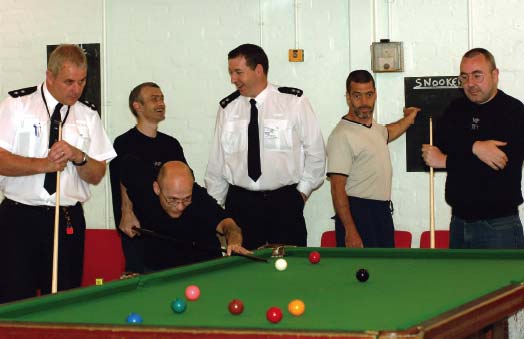
Every single report published in 2006-2007 found good relationships between staff and prisoners. This is a remarkable achievement. In last year's Annual Report I commented as follows under the heading "The most surprising fact": in the annual SPS Prisoner Survey the answer given to the question about relationships with prison staff is nothing short of astonishing. To the question "How do you rate relationships with staff in your prison?" the number of prisoners who replied "ok or better" was, this year, 95%. Only five prisoners out of 100 feel that they are not properly treated by prison staff. That astonishing figure is supported by the evidence of inspection after inspection.
I think that could be said at least equally positively this year: surprisingly, the SPS did not include the question in the 2006-07 Survey.
Good contact with family and friends is maintained
Research evidence points to the importance of good family contact for reducing reoffending on release. Issues
of family contact are perhaps the most frequent issues raised by prisoners with inspectors - a sign of their importance. The difficulties are great. Some prisons are difficult to reach and the families of most prisoners are poor. In particular the families of prisoners held in a central facility rather than a local prison may have considerable distances to travel: that means the families of imprisoned women, serious sex offenders and young men.
Some prisoners have no family and no friends. For years a system of volunteer visiting organised by HOPE spread through several prisons from its beginning in Barlinnie. It is disappointing to discover that the reduction of funding has led to a reduction in the provision of this important and appreciated service.
Visits are very important for family contact. Some visit rooms do not make it easy: Aberdeen, Peterhead and Cornton Vale are poor facilities. So was Glenochil: but this year, as part of the new building programme, an outstanding new visit room has opened there. When a visit room is cramped and staff have to be very close to prisoners and their families, it is very difficult for a visit to be a positive experience. A splendid visit room, like the one at Glenochil, makes a visit much more likely to be positive and valuable, and so important for reducing reoffending.
 |
 |
But it is not only the visit room which can promote good contact with family and friends. In Edinburgh, for example, the families of prisoners participate in the induction to prison of new prisoners. At the end of a two week induction programme family members will be invited into the prison setting to help them understand the circumstances of imprisonment and to meet the staff most involved with the prisoner in question. The same project has been developed in Polmont. In Shotts, there are father and child visits and also a two-hour quality visit per month, which offers the opportunity to take family photographs. A number of other initiatives are in place including family cinema days and Christmas Dinner. A Family Consultation Forum is in place which offers families the opportunity to make suggestions and consult with visits staff.
The most significant developments in family contact in the last year have been the development of Home Detention Curfew and Extended Home Leave. Both of these schemes mean that prisoners will be spending longer periods at home. Extended Home Leave makes possible 'Continuous Cell Occupancy' at the Open Estate. The inspection report on the Open Estate says Concerns expressed by the Inspectorate about the administrative arrangements for CCO and the EHL scheme which works alongside it have been addressed. Staff have worked hard to ensure that the scheme functions. With a full week at home at a time, there is an opportunity for dramatically increased family contact, which prisoners and staff indicate is very beneficial. It is too early to have access to any evidence from community social work about any adverse effects the scheme might be having on family members.
Prisoners' entitlements are accorded to them in all circumstances without their facing difficulty.
In past years there have been difficulties for prisoners in terms of "privileged correspondence" (letters from lawyers, courts etc., which must be opened only by the prisoner). No such matters were discovered during 2006-2007. Members of Visiting Committees meet inspectors during every inspection; and they always affirm that they meet no hindrance in the matter of free access to prisoners.
The Complaints system is a sign of the free exercise of the rights of prisoners. It is an important guarantee of the rights of prisoners. The report on Peterhead drew attention to an anomaly about the pattern of prisoners' complaints. For some time the highest concentration of complaints received by the Scottish Prisons Complaints Commissioner ( SPCC) has been from Peterhead. In 2005 a number of prisoners were transferred from Peterhead to Dumfries. The Report on Peterhead comments. The figures are remarkable. … in 2005-2006 59% of all complaints received by the SPCC came from Dumfries (37%) and Peterhead (22%) together. This report and the last Report on Dumfries provide evidence that the conditions and treatment of prisoners in these two prisons are not worse than in other prisons. It is no more difficult to lodge a complaint in one prison than in another. A possible interpretation of the very large number of complaints in Peterhead prison is that it is an attempt to frustrate the normal working of the prison. The trivial nature of many of the complaints suggests that is true.
One of the indicators of this outcome about legal entitlements used in the Standards document is Segregation is used sparingly and in accordance with procedures. In a Segregation Unit a prisoner will have contact with no other prisoner. It is very important that independent inspection strengthens the determination of the SPS to ensure that segregation is never used indiscriminately.
Prisoners take part in activities that educate, develop skills and personal qualities and prepare them for life outside prison.
Peterhead: work is not available to all prisoners. Glenochil: there is not enough for prisoners to do. Barlinnie: there are not enough opportunities for prisoners to participate in purposeful activity.
Shotts: there are very few training opportunities in the workshops.
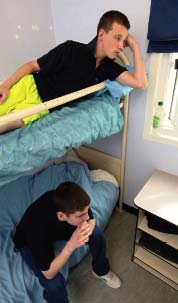 |
 |
Report after Report tells the same grim story. The law requires prisoners to work. The public expects prisoners to work. Yet in nearly every prison many prisoners are not working. When they should be working - indeed, often when they want to work - there is no work for them. When prisoners are not working they are almost invariably locked in their cells.
A useful working day for a prisoner could make such a difference. It could teach good habits of punctuality and self-discipline. It could be a training opportunity to develop a skill to help with employment on release. It could transform the self-respect of prisoners who had never done a decent day's work in their lives and never made anything useful or beautiful. It could keep the minds of prisoners focused on things that are valuable rather than on things that are destructive. It is no surprise that the public expects prisoners to work. But the reality is that prisoners - many of them - spend the working day lying in bed. Usually this is not about laziness: usually it is about overcrowding. In an overcrowded prison there is always someone ahead of you in the queue for work.
Those who have the most empty and frustrating day are prisoners on remand. In several prisons they may make up to one third of the prisoner numbers. Almost universally they take no part at all in any activities that educate, develop skills and personal qualities and prepare them for life outside prison. Prisoners on remand are not required to work: as a result they hardly ever have the opportunity to work. It was therefore heartening to find that some modest provision is being made in Perth for prisoners on remand who want to work.
The quality of learning offered in prison is high; at the same time access to education is limited. Very many prisoners have obvious educational needs. Perhaps prisons could do more to encourage them to learn: but the sad reality is that their education is another victim of overcrowding and high numbers. Some of the new facilities buildings contain splendid Learning Centres: but they are not designed to provide a service for any more than a small proportion of prisoners. If prisoners leave prison with no more learning than they had when they came in (if, for example, they leave unable to read and write) their chances of employment are very low, and that means that their chances of reoffending are very high.
Healthcare is provided to the same standard as in the community outside prison, available in response to need, with a full range of preventive services, promoting continuity with health services outside prison.
Within a few days of his appointment in 2006, the Governor of Cornton Vale said "I am shocked by the high numbers of mentally ill people we have to deal with." It is a mistake to think that Cornton Vale is completely different from other prisons. All prisons hold prisoners with mental health problems; and the number seems to be increasing. So often has this aspect of prison life been mentioned in the last year that a thematic inspection is being undertaken of mental illness in Scottish prisons by my inspection team.
I met a prisoner in a Segregation Unit. His story was very sad. He could not function properly in the community: because of his mental health difficulties sooner or later something would go wrong and he would find himself charged with a minor offence like breach of the peace. Efforts would be made, but no other option could be found for him than prison. So he had a long history of imprisonment, although never for anything very serious. In prison he could not function very well either: so he tended to end up completely on his own in segregation units. On the day I met him he was unkempt and smelly, his conversation - and his singing - was so bizarre it was almost impossible to understand, and he was spending all day every day in his bed completely alone. Any visitor (in fact he never had any) could not fail to be impressed with the care shown to this misfit by prison staff: but it was impossible to conclude that these stays in prison were doing him (or anyone else) any good.
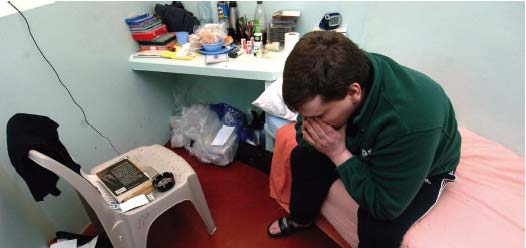
The mental illness of prisoners when they arrive in prison presents huge challenges to the Scottish Prison Service. Last year's Annual Report called for a new approach to healthcare The time has come to examine the possibility of the provision of healthcare in prisons by the National Health Service. That was written in the context of the gap in healthcare provision which so often occurs when a prisoner is released into society. As the example above suggests, it is a particularly important concern with regard to those who suffer from mental illness, who seem to find it very difficult indeed to link into care in the community.
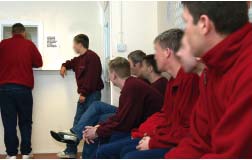 However demanding the provision of proper mental healthcare is in prisons, it is not the most demanding aspect. Behind the vast majority of complaints that inspectors hear about healthcare (and with the exception of food they hear more complaints about healthcare than about anything else) is addiction. The provision of methadone, of detox treatments, of "something to help" takes up an enormous amount of time and effort for doctors and nurses in prisons, and provides limitless opportunities for disagreement between prisoners and health professionals, with accompanying stress and tension. The Report on Barlinnie shows that at the time of inspection 305 prisoners were receiving methadone every day. Since methadone has to be administered in strictly controlled circumstances, the logistics of this dispensing are very demanding indeed.
However demanding the provision of proper mental healthcare is in prisons, it is not the most demanding aspect. Behind the vast majority of complaints that inspectors hear about healthcare (and with the exception of food they hear more complaints about healthcare than about anything else) is addiction. The provision of methadone, of detox treatments, of "something to help" takes up an enormous amount of time and effort for doctors and nurses in prisons, and provides limitless opportunities for disagreement between prisoners and health professionals, with accompanying stress and tension. The Report on Barlinnie shows that at the time of inspection 305 prisoners were receiving methadone every day. Since methadone has to be administered in strictly controlled circumstances, the logistics of this dispensing are very demanding indeed.
There are therefore two reasons which make it not straightforward to compare healthcare in prisons with healthcare in the community, as the Standards Outcome demands. One is the disproportionately bad health of prisoners as they come into prison; the other is the disproportionately high number of prisoners with addiction problems. There are some common features in the inspections carried out in the past year. Dental services are difficult to find, and prisoners often have a long time to wait before seeing a dentist. The triage system to see a doctor is universally unpopular among prisoners. When new facilities buildings provide new health centres the improvement in services, treatment, working conditions for staff and morale is very noticeable.
Appropriate steps are taken to ensure that prisoners are reintegrated safely into the community and where possible into a situation less likely to lead to further crime.
The first one was in Edinburgh. Now most prisons have a Links Centre, and each one represents a recognition of the importance of reintegration into society of released prisoners. Within Links Centres connections (or "links") are made with housing agencies, employment agencies, addiction services and so on for prisoners as they approach liberation. Making a connection with Jobcentreplus is not the same as walking out into a job: but it is good to be able to report that very few prisoners who have been in prison for any appreciable time will be released without something having been done to find support for reintegration on the outside.
The Open Estate is at the centre of the SPS strategy for the reintegration of prisoners into society. The opening of the Links Centre at Castle Huntly (and now at Noranside as well), the opportunities for reintegration into the home community provided by Extended Home Leave, and the development of excellent community placements were cited in the Report in 2006 as "evidence of real improvement".
In Barlinnie the Routes out of Prison Project, run in partnership with the Wise Group, had just begun at the time of inspection. This project uses ex-prisoners to work with current prisoners with particular reintegration difficulties both in prison and in the community on release. The early signs of this project are exciting. It operates in Polmont and Cornton Vale as well as in Barlinnie. The following story from a young man released from Polmont may not sound much to those who do not know his world; but it is truly an inspiring story of something that has really worked.
Upon leaving prison I thought that I was not going to have much of a life at least for a while because I was 18, just out of prison and I had it in my head that nobody would employ me. When in prison and just before my release I met with a Wise Group worker but when I got out of prison I never really thought I would speak to any of them again. I received a letter from a life coach asking me to get in touch with him, as he was my new life coach he wanted to meet to see how I was getting on. We had a meeting and I told him what I wanted to do, and what qualifications I had. After that meeting we arranged another meeting during which we would get some job applications filled in and posted away. My life coach also looked into where training schemes were near to my home and that I could consider going for more qualifications. Luckily I got an interview and got the job. The Wise Group played a great part in getting me this job - with just a little bit of help and someone to talk to without getting classed as a thug. Once in my job my life coach kept in touch to see how I progressed in work and to this day I am still in work and have put prison in the past.
If it was not for the help that I got from the Wise Group and my life coach I think that I would still be on the job seekers allowance, sitting around the house doing nothing, or more realistically ending up back in prison, possibly this time for a much worse crime than before. I would like to give thanks to all those who helped me make prison a distant memory, for the support and chats that made me feel as if there were people who actually wanted to give me help. THANKS
 At the centre of the project is a group of ex-prisoners giving support and help to prisoners on release. One of these life-coaches writes:-
At the centre of the project is a group of ex-prisoners giving support and help to prisoners on release. One of these life-coaches writes:-
I am 40yrs of age, and after 20yrs of being caught up in a turbulent past of alcohol, drug addiction and prison I had to change. I remember thinking at the time, who on earth is going to employ me with 40 odd previous convictions and a drug addiction. A representative from the Wise Group made arrangements to meet me and she told me about the life-coaching project that employed ex offenders to work with offenders. This sounded great to me as I had never heard of anything like this. She set up an interview for me and I went along, things went well and they wanted a second interview and hey presto I got the job.
During the next six months at the life-coaching project I got certificates for health and safety, first aid mental health and mental health assistance that trains you to spot clients who may be suicidal or may self harm. I also did stress awareness and presentation skills. My confidence was getting stronger and I started taking responsibility for the events in my life that had landed me in so much trouble. I made the decision that my destiny was not a matter of chance but a matter of choice and I was going to make the right choice and change my life forever.
By now I was really motivated and loved the project that had helped me see things in a different way. Even things at home were getting better and my family and new friends were giving me lots of support. Then I learned that the life coaching project had been nominated for the Butler Trust Award and the Wise Group asked me to go to Buckingham Palace on behalf of the project. The award we had won was the Lord Woolf award, and we were being presented with the award by Princess Anne at Buckingham Palace. There are no words to explain the feelings I had that day when we got the award and Princess Anne actually spoke to me about the project and the excitement and interest the project had generated that day by royalty, prison governors, lords and ladies and all the people involved with the Butler Trust. It was unbelievable to say the least.
I know this project can help change people's lives. It was only the other day that I got a call from a client who has a lot of issues going on in his life and he didn't know how to deal with them or even where to make a start. After meeting with the client I now have him engaging with the addiction services to control his alcohol addiction. He is taking the proper medication and reducing his alcohol intake, and I am in the process of setting him up with some respite, so he can make that final step to combat his addiction. It was only a couple of weeks ago when this client called me saying that he was so down and depressed that he didn't know what to do or where to turn for help. Even in this short time I have supported him I can see a big difference in his attitude and his behaviour. I could sit all day and tell you of lots of different stories of clients that I have helped but that's not important, what is important is that the support and the advice is there for the client and if they make that decision to change their life then I will support them. Remember life isn't a matter of chance it's a matter of choice.
However, the Scotland into which prisoners are released remains the Scotland from which they were convicted. Whatever has happened to them in prison, they are being released into a community in which they have the worst chance of finding employment, in which decent housing is going to be very difficult to find, in which hard drugs and alcohol will be widely available and there will be many so-called friends encouraging them to indulge. Very seldom will they be returning to happy stable family homes. Even if everything went very well for them in prison, the Scotland which awaits them will be tough. And for most of them what has happened in prison will have made little difference. The bad health they brought in with them will leave with them; the low educational attainment they brought in with them will leave with them. The low self-confidence and low self-esteem they brought in with them will leave with them. The friends they left behind will be waiting for them. For many such ex-prisoners it will be very difficult to stay away from crime. The result will not be good for them, and not good for us all.
There are so many people in prison who have been defeated by life. Of course there are many people in prison who have committed terrible crimes, crimes of violence, crimes against women, crimes against children. But it is painfully true that in any prison are many who have drifted into a life of crime because they have not managed to do anything better. Prison serves as the gathering place for those whose misfortune and whose bad choices send them there because there is no better place for them to go to.
If prisons can become the dumping grounds of society, in some ways they mirror an institution which is no longer with us. No one regrets the disappearance of that most pernicious Victorian institution, the workhouse. Simon Fowler has written a history of such places in England and Wales. He quotes the campaigner for the poor, Robert Pashley, who wrote the place known as the workhouse was in truth a general hospital, an almshouse, an idiot house, a blind asylum, a deaf and dumb asylum - and a workhouse. They became dumping grounds for children, the elderly, the lunatic and the diseased. Workhouses have disappeared, but all too often prisons have taken their place and fulfil the same role in society.
Which comes back to better prisons and a better Scotland. It cannot be repeated often enough that that we will only have better prisons when we have a better Scotland; and we will have a better Scotland when we have better prisons.
A good start would be the abolition of the imprisonment of children. Prison is no place for a child. Two years ago I expressed my shock and anger at the number of children under the age of 16 held in Scottish Prisons and Young Offenders' Institutions. After that the number increased from 18 in 2004-05 to 24 in 2005-06. Last year I expressed myself more gently Our prisons would be better if it could be resolved that this year would be the last year in which any child under the age of 16 would be held in a prison or young offenders' institution. In fact the number this year has gone from 24 to 26. I repeat: a good start to better prisons in a better Scotland would be the abolition of the imprisonment of children.
2. Summary of Inspections Undertaken
Establishments
HMP Peterhead
Full inspection 1-5 May 2006
- There have been no escapes since the last inspection.
- Slopping out continues.
- The future of the prison is still uncertain.
- Prisoners feel safe and relationships between staff and prisoners are good.
- Induction arrangements for new prisoners are excellent.
- PE, laundry and catering arrangements are good.
- The provision of learning, skills and employability is good. However, work is not available to all prisoners, and not all workshops that can provide qualifications do so.
- A large number of complaints is made by a small number of prisoners.
- Pre-release arrangements for prisoners are poor.
- Not all prisoners have an allocated supervising social worker in the community, and the link between prison and community social work resources is not always adequate.
- Facilities for visitors arriving at the prison and for visits remain poor.
- There is a long waiting list for programmes, especially the STOP programme.
- Staffing issues are causing problems in the health centre.
- There is complacency towards addictions issues.
HMP Barlinnie
Full inspection 9-18 August 2006
- There had been no escapes in the past year.
- The end of slopping out and the refurbishment of parts of the prison have created much better conditions for staff and prisoners, and a much calmer atmosphere.
- Relationships between staff and prisoners are good.
- The catering arrangements have improved in most of the prison.
- An excellent 'First Night Centre' has been opened.
- The library is excellent.
- Advances have been made in the provision of chaplaincy and psychology.
- Prisoner numbers are very high; and overcrowding is very high.
- The conditions of and opportunities for remand prisoners are poor and limited.
- The cubicles in Reception remain unacceptable.
- There is a shortage of nursing staff.
- There are concerns about the provision of care by doctors to prisoners and about resolving complaints made by the prison to the healthcare provider.
- There are not enough opportunities for prisoners to participate in purposeful activity, but some of the vocational training opportunities are very good.
- Arrangements in the area of Race Relations have deteriorated.
- Only a few prisoners are allowed any personal clothing and the laundry arrangements for all prisoners is inadequate.
The Open Estate
Follow up inspection 18-20 September 2006
- There has been a good response to concerns raised in previous inspections.
- Murray House has opened, providing 141 places. This accommodation is very good.
- The dormitories in Wallace Wing and Bruce Wing have been converted and now provide much better accommodation.
- The Links Centre has opened and is a good facility providing a focus for activity in Castle Huntly.
- Continuous Cell Occupancy has started in Noranside. This provides an additional 27 prisoner places. The arrangements have been managed very well, but the impact on the rest of the regime is significant and needs to be monitored.
- Prisoners are spending less time locked in their rooms in Castle Huntly.
- Additional resources have been provided for social work and addictions and both of these departments are now better able to cope and are providing a very good service.
- The replacement of Sentence Management with Integrated Case Management has settled in well and provides a clearer structure and closer working relationships.
HMP Glenochil
Full inspection 2-6 October 2006
- There have been no suicides or escapes in the past year.
- Relationships between staff and prisoners are good.
- The extensive changes to the fabric of the prison have been well managed.
- Most prisoners are now in an impressive new accommodation hall. However, the new hall is very hot most of the time, and very noisy during recreation periods.
- Some prisoners now have to share cells. This is unusual for long-term prisoners, and it generates anger.
- There is not enough for prisoners to do.
- A new Violence Prevention Programme has been introduced. This is beginning to create a blockage in the progression system.
- Protection prisoners are in the poorest accommodation, and have least access to a range of facilities and opportunities.
- The quality of the catering service has deteriorated. Prisoners were very critical of the amount and quality of food provided.
- The visits room is inadequate. A new visit area was under construction during the inspection.
- Integrated Case Management is settling in well.
- The provision of education and training is excellent for a small number of prisoners. However, most prisoners do not have access to it.
- In spite of the dated facilities the standard of healthcare is good. The dental service and the Healthcare Forum are particularly impressive features.
- The health and social care components of addictions services are jointly managed and well linked.
HMP Edinburgh
Follow up inspection 24-25 October 2006
- An excellent new building housing the Reception, kitchen, laundry and workplaces has opened.
- There has been an improvement in the condition of the furniture, bedding and clothing of remand prisoners.
- Initial indications are that the replacement of Sentence Management with Integrated Case Management has been well managed.
- Prisoners on remand have little to do.
- There is an increasing number of prisoners with serious mental health problems.
- Some long-term prisoners are still required to share cells. This is generating anger.
- The way in which medication is dispensed in the residential areas continues to be unsatisfactory.
HMP & YOI Perth
Follow up inspection 5-6 December 2006
- The prison is currently undergoing major building work. This has led to reduced accommodation capacity and constant movement within and out of the prison. All of this has been very well managed.
- Friarton Hall is now a Young Offenders' Institution. The change has been well managed: the young adults and staff are very positive about the development.
- There is an excellent new prisoner activities area, laundry and kitchen.
- The food has improved significantly.
- Prisoners feel safe and there has been a reduction in violence.
- Some remand prisoners are allowed to work and can gain qualifications.
- Most prisoners have to share a cell and the conditions in 'E' Hall are poor.
HMP Shotts
Full inspection 12-16 February 2007
- There have been no escapes in the past year.
- The prison is safer and calmer than it has been for many years.
- Relationships between staff and prisoners are good.
- Arrangements for maintaining contact with families are very good.
- Early evidence of the operation of Integrated Case Management is encouraging.
- Unscreened toilets in cells detract from living conditions which are otherwise decent.
- Education is good but access is limited.
- There are very few training opportunities in the workshops.
- Some prisoners are delayed in their progression towards a top-end or open conditions as a result of the numbers requiring to participate in the Violence Prevention Programme.
- The triage system to see the doctor creates problems for prisoners and staff.
- Arrangements for suicide risk management are inadequate.
HMP Greenock
Follow up inspection 6-7 March 2007
- There have been no escapes in the past year.
- The prison suffers from high overcrowding, as a result of which prisoners in 'A' Hall spend too much time locked in their cells.
- Despite high overcrowding, a good standard of food, staff and prisoner relationships, and family contact has been maintained.
- The high overcrowding and rapid turnover of prisoners makes it almost impossible to maintain an acceptable standard of furniture and decoration.
- Toilets in cells, including cells in which prisoners are sharing, are not enclosed.
- The arrangements for health care have improved significantly.
HMP & YOI Cornton Vale
Follow up inspection 19-20 March 2007
- There had been no escapes since the last inspection.
- The physical and mental health of most women entering Cornton Vale is very poor.
- Prisoner numbers continue to rise, and a fire in one of the residential areas has put even more strain on facilities.
- As a result of the electronic locking system, it could be possible for a woman to have to wait for an hour before being given access to the toilet.
- There is a lack of purposeful activity for prisoners on remand.
- The closure of accommodation for women in other prisons means that some women have very long journeys for court appearances.
- The unacceptable practice of handcuffing all women under escort, regardless of level of risk posed by the individual or the location, continues.
Other Reports
The Conditions and Treatment of Prisoners Under Escort
Inspection June - October 2006
- The logistics of escorting prisoners around Scotland is complex, and has grown considerably since the Reliance Custodial Service contract commenced. The overwhelming majority of escorts are managed without incident or difficulty of any kind.
- The relationship between RCS staff and prisoners and the general approach of RCS staff is positive and constructive.
- Prisoners feel safe from staff and other prisoners in vans.
- At a small number of courts, it appears difficult, with the current layout and operational arrangements, to guarantee the safety of prisoners and staff when moving into and through the court building.
- The lack of risk assessment and other documentation at some courts means that staff who are unused to that particular court cannot immediately access information they may require.
- The information contained in prisoners' Personal Escort Records is inconsistent and inadequate to facilitate the management of prisoners with additional needs, or who pose risks to themselves or others.
- The conditions under which prisoners are kept in court cells are very variable, with some being extremely poor. Cleanliness is an issue in a significant number of courts. There are also a range of issues with toilet arrangements across a wide range of courts.
- The management of new prisoners is not consistent, and does little to identify any needs they may have, or any risks they may pose. There is a lack of information for new prisoners on basic issues such as prison reception procedures and visiting.
- Delays in the escorting process appear endemic, and have wide ranging consequences.
- Some children are being delivered to prison late at night when it is difficult for staff to adequately address their needs. Some who are destined for social work facilities are being required to spend a night in prison because they cannot reach their intended destination.
Standards Used in the Inspection of Prisons in Scotland
Published August 2006
- The standards used in the inspection of prisons in Scotland represent a significant step towards the demonstration of consistency and transparency.
- Scotland is very unusual in having independent inspection of prisons. Many other countries have no system of prison inspection: of those that do, inspection is usually carried out by prison officials or by judges. In Scotland, the Chief Inspector is independent of the Scottish Prison Service and of the Scottish Executive.
- These standards reflect the independence of the inspection of prisons in Scotland. They have been developed from the actual practice of such inspecting. While the basis for these standards is rooted in international human rights treaties and conventions and in prison rules, they are our own standards.
- The publication of these standards is designed to enable prisoners and prison staff to understand the main areas to be examined in the course of an inspection and what would be expected in each area; and to provide assurance to Ministers and the public that inspection is being carried out within a consistent framework and that measurements are being made against appropriate standards.
3. Review of the Prison Inspectorate's Year 2006-2007
Inspections and Other Reports
Inspections for the year were completed as follows.
|
Full Inspections |
|
|
HMP Peterhead |
1-5 May 2006 |
|
HMP Barlinnie |
9-18 August 2006 |
|
HMP Glenochil |
2-6 October 2006 |
|
HMP Shotts |
12-16 February 2007 |
|
Follow Up Inspections |
|
|
The Open Estate |
18-20 September 2006 |
|
HMP Edinburgh |
24-25 October 2006 |
|
HMP & YOI Perth |
5-6 December 2006 |
|
HMP Greenock |
6-7 March 2007 |
|
HMP & YOI Cornton Vale |
19-20 March 2007 |
|
Other Reports |
|
|
The Conditions and Treatment of Prisoners Under Escort |
June - October 2006 |
|
Standards Used in the Inspection of Prisoners |
Published August 2006 |
Submission to the Scottish Parliament
The 2005-2006 Annual Report was laid before the Scottish Parliament on 1 November 2006.
Staff
|
March 2007 |
April 2006 |
|||
|
HM Chief Inspector |
Dr Andrew McLellan |
(F/T) |
Dr Andrew McLellan |
(F/T) |
|
HM Deputy Chief Inspector |
John McCaig (from 2 October 2006) |
(F/T) |
Rod MacCowan (to 18 August 2006) |
(F/T) |
|
HM Assistant Chief Inspector |
Dr David McAllister |
(F/T) |
Dr David McAllister |
(F/T) |
|
HM Inspector |
David Abernethy |
(F/T) |
David Abernethy |
(F/T) |
|
Personal Secretary |
Janet Reid |
(F/T) |
Janet Reid |
(F/T) |
A list of Specialist and Associate Inspectors for the year is provided below.
|
HMP Peterhead |
|
|
Alastair Delaney |
Education Adviser |
|
Peter Connelly |
Education Adviser |
|
Sean Doherty |
Healthcare Adviser |
|
Alna Robb |
Healthcare Adviser |
|
Irene Scullion |
Addictions and Social Work Adviser |
|
HMP Barlinnie |
|
|
Stewart Macfarlane |
Associate Inspector |
|
Jim Rooney |
Education Adviser |
|
Peter Connelly |
Education Adviser |
|
Stewart Maxwell |
Education Adviser |
|
Sean Doherty |
Healthcare Adviser |
|
Dr Malcolm Kerr |
Healthcare Adviser |
|
Katie Lamb |
Addictions and Social Work Adviser |
|
HMP Glenochil |
|
|
Stewart Macfarlane |
Associate Inspector |
|
Iain Lowson |
Education Adviser |
|
Karen Corbett |
Education Adviser |
|
Donald MacLeod |
Education Adviser |
|
Rhona Hotchkiss |
Healthcare Adviser |
|
John Waterhouse |
Addictions and Social Work Adviser |
|
Margaret Daly |
Associate Inspector |
|
Gunnar Oldfelt |
Observer, Swedish Prison and Probation Administration |
|
HMP Shotts |
|
|
Sandra Hands |
Associate Inspector |
|
Alastair Delaney |
Education Adviser |
|
Lesley Brown |
Education Adviser |
|
Phil Denning |
Observer, HMIE |
|
Rhona Hotchkiss |
Healthcare Adviser |
|
John Waterhouse |
Addictions and Social Work Adviser |
|
Dr Chris Valentine |
Associate Inspector |
The Conditions and Treatment of Prisoners Under Escort
Alan Coyne - Associate Inspector
James Reddington - Associate Inspector
Reid Howie Associates - Research Advice and Support
Standards Used in the Inspection of prisons in Scotland
Professor Andrew Coyle and the staff of the International Centre for Prison Studies
Finance
The Inspectorate's budget for 2006-2007 was £363k. Of this:
|
Staff costs for five full time staff |
£306k |
|
The Conditions and Treatment of Prisoners Under Escort |
£ 43k |
|
Advisers, training, travel and subsistence and other running costs |
£ 14k |
Communications
Recent reports can be found on our website ( www.scotland.gov.uk/hmip ).
Email: andrew.mclellan@scotland.gsi.gov.uk .
